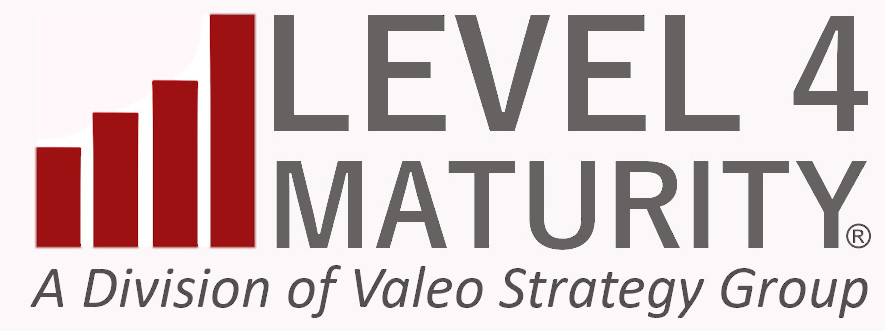Maturity Level assesses the degree to which all areas of an organization are aligned with its CEO’s strategy for revenue growth.

About Level 4 Maturity
Businesses that are still operating in silos, consciously or unconsciously, are losing ground when it comes to achieving industry leadership and increasing topline revenue growth. Maturity Level assesses the degree to which all areas of an organization are aligned with its CEO’s strategy for revenue growth. Based on our research, achieving Level 4 Maturity is one of the important strategic goals an organization should pursue to maximize revenue growth.
Becoming Collaborative
Collaboration across teams is an important step in reaching Level 4 Maturity. It means taking colleagues in other areas of operation out to lunch, having coffee with them, attending their monthly staff meetings. The goal is to understand what is driving them. Divisional objectives, key strategic initiatives, and what significant challenges exist are all important insights to garner. When you become more involved with the community, you will gain more credibility and come to understand how your own performance impacts the overall revenue growth of the organization.


How Current Technologies Create Challenges
Pushing up against the need to dismantle silos are advances in technologies such as Artificial and Business Intelligence that are reducing the need for human participation in “check the box” type job functions. Many roles that tend to remain limited within silos, where more time is spent “checking the boxes” of a job versus aligning with the CEO’s corporate strategy, will experience diminished relevance to their employers.
Through collaboration, now is the time to break down silos, stop checking boxes, and integrate with internal stakeholders to develop the expertise that will support corporate-wide strategy. Gone are the days when some departments are seen as non-revenue-driving. To excel in today’s marketplace, every department, every employee, must be actively aligned with and working toward CEO revenue growth objectives.
Toppling Silos +
Fostering
Collaboration =
Topline Revenue Growth
Leadership should be employing these tactics to ensure topline revenue growth for their companies; a side benefit will be that doing so will also help to secure jobs and advance careers. The essential component is taking steps now, on one’s own, rather than waiting on dictates from upper-level management.
Equally important, senior management needs to recognize the strong impact that a high-functioning, department – once set free from the restrictions of working in a silo can have on growing revenue. If a department isn’t prioritizing strategic goals from the outset, a domino effect follows and those goals get muddied, overlooked, or lost in the process. The company is ultimately harmed and unable to achieve top level revenue or create new products and services.
The key takeaway is that yes, AI and BI can do a lot of tasks and check a lot of boxes, but relationships and the value-add of meaningful collaboration are irreplaceable. Teams and departments that break free from the confines of a silo mentality and dedicate themselves to collaborating with business partners at a “level four” of maturity – those are the teams that most consistently and meaningfully deliver results in supporting, and not hindering, topline revenue growth.


Assessing Maturity
No team or department should let itself stay in an adolescent level of maturity. Adolescent maturity is where tasks are completed, and boxes are checked, working inside a vacuum. The goal should be to focus on the overarching strategic and revenue goals of the business. All teams should aspire to grow up and become an integrated contributor to topline revenue success.
The first step is to assess the current maturity level by asking the following questions about the department:
- Does it focus mostly on tactical functionality?
- Do team members keep to themselves and avoid opportunities to connect with other departments?
- Does the team behave as if it is operating within a silo, uninvolved in the CEO’s strategic plan?
- Does the team leave strategic planning and product and service ideation to others?
- Does the team understand the CEO’s strategic plan and are we using that plan as a guiding framework for how we approach all our efforts?
A “yes” answer to any of these questions is an indicator of where the department could lean into greater maturity
Follow the Proven Path
There are proven best practices that can guide you to reaching your own successful Level 4 Maturity. By taking these steps, you will come to clearly understand your current state, the state of your industry, develop targets, identify the best external resources needed, create meaningful plans, and measurements of success. These include building:
- Intelligence and analysis of best practices in your own and adjacent industries.
- An understanding and comparison of your current level of maturity and its impacts.
- An unobstructed vision of what Level 4 Maturity means for your organization.
- A correct plan on how to get there (this includes the right people, technologies, and other tools).
- External support to help build the plan and guide success.
- The means of measuring success and realigning as needed.


You May Not Know What You Do Not Know
Valeo’s experience has taught us that a large majority of executives, and very often those at many of the largest companies, are unfamiliar with the concept of blinded primary qualitative intelligence. Typically, their experience includes more traditionally known quantitative studies that yield statistical validity. However, the plan for achieving Level 4 Maturity will require a different kind of deep study into your top competitors and other organizations that have achieved top revenue results. It will require external resources that can conduct blinded research directly with key industry participants, combined with an analysis of the findings. It is from this process that reaching Level 4 Maturity begins.
Understanding the Market
Measuring and comparing Maturity Level to key competitors involves using research tools to better understand the current state of how effectively an organization is working in collaboration with other departments within the organization.
Professional Competitive Intelligence research firms are able to legally and ethically study your competitors and your own organization with the goal of creating a clear comparison. From these findings, a meaningful understanding of where the gaps lie will serve as the map that helps guide success.
Important questions will be answered such as:
- How siloed are your competitors’ organizations?
- What key performance indicators (KPIs) have they created to measure their performance?
- How effective have they been at achieving those KPI’s and why?
- How well are they aligning each operational area with their CEO’s strategy for revenue growth?
- What has been the impact?

